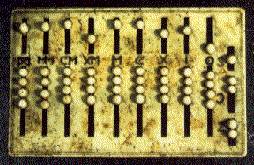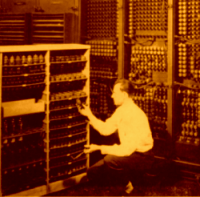|
Information Technology Enables Businesses
Information technology is nothing new, but as it has evolved it has continued to change the way we live and do business. From the days of cave paintings to today's modern computer networks, evolving information technology has enabled each of us to better record, locate, evaluate and communicate information with others.
The abacus is believed to have been invented as a simple counting aid in Babylonia (now Iraq) in the fourth century B.C. The Greeks, Romans, Chinese, Japanese and Russians all developed different designs to fit their needs. Since the middle ages, growing businesses have needed new ways to keep information about vendors, customer orders and purchases. Evolving technologies have provided new tools to help keep records and communicate with others. Around 1455, Johann Gutenberg used movable type to create the first printed Bible. This innovation furthered the improvement of literacy and learning. It also provided the technology for creating printed advertising at a more reasonable cost. Store owners used quill pen and ink to keep records of orders, inventory, costs and sales, and to correspond with vendors and customers. Adding machines were introduced during the 1820's, and became more widely available during the 1870's, allowing business owners to calculate costs of goods, accounts and invoices more quickly. Typewriters became available in the 1870's. Together, they changed the standard for business correspondence, billing and record keeping. Technologies Enable Reaching Distant Customers
To ship their catalogs, receive customer orders and ship their diverse variety of goods to customers far away from their warehouse, they used the distribution system provided by the expanding railroads. While the mail order concept wasn't completely new, their catalog which utilized mass printing technology and the expanding transportation technology, revolutionized marketing and sales. Computers Provide Faster Business Information Technology In the 1880's, Herman Hollerith invented a punched card device to help analyze the 1890 US census data which used electricity to read, count, and sort punched cards whose holes represented data gathered by the census-takers. It accomplished in less than one year what would have taken nearly ten years of hand tabulating. His new company next supplied punched-card equipment to the Prudential Life Insurance Co. to speed up manual processes of sorting, counting, and adding numerical data; and to the New York Central Railroad to chart freight movements and process up to four million waybills each year. The first general purpose programmable electronic calculator was the Z3 completed by Konrad Zuse, an aircraft construction engineer, in Berlin, Germany in 1941. Professor John Atanasoff and graduate student Clifford Berry built the world's first electronic-digital computer at Iowa State University between 1939 and 1942.
During the early 1950's Remington Rand's Univac Division and IBM introduced faster large computers for compiling census statistics; computing engineering calculations; and business applications such as billing, payroll and inventory control. In 1957 IBM introduced the IBM 305 Random Access Method of Accounting and Control (RAMAC), the first computer disk storage system. As technology continued to develop during the 1960's businesses and the government found new ways to use computers such as American Airline's SABRE "real time" reservation system, NASA's tracking the orbital flight of the Mercury astronauts and help man land on the moon. Today the widespread use of Personal Computers, Local Area Networks and the Internet have allowed almost all businesses to work more efficiently and achieve new goals.
|

 Technology
has been a central part of our history as a product of innovation, a carrier
of change, and a tool we use in our daily lives which helps us shape our
future. Technology began to make a difference as early as as about 3500
B.C. when people began to replace their stone tools and weapons with more
efficient bronze ones, giving those who owned them a competitive edge.
Technology
has been a central part of our history as a product of innovation, a carrier
of change, and a tool we use in our daily lives which helps us shape our
future. Technology began to make a difference as early as as about 3500
B.C. when people began to replace their stone tools and weapons with more
efficient bronze ones, giving those who owned them a competitive edge.
 During
the nineteenth century America became a sprawling, growing country, creating a vast new market
for goods. Richard Warren Sears and Alvah Curtis Roebuck recognized an opportunity to reach this
expanding audience by producing a printed catalog which provided information about their wares
in 1888.
During
the nineteenth century America became a sprawling, growing country, creating a vast new market
for goods. Richard Warren Sears and Alvah Curtis Roebuck recognized an opportunity to reach this
expanding audience by producing a printed catalog which provided information about their wares
in 1888. ENIAC
was completed by John Mauchly and J. Presper Eckert in 1946. Their research
was sponsored by the US military to assist in the preparation of firing
tables for artillery. The ENIAC contained 17,468 vacuum tubes, along with
70,000 resistors, 10,000 capacitors, 1,500 relays, and 6,000 manual switches.
It covered 1800 square feet of floor space, and could complete up to 5,000
operations per second.
ENIAC
was completed by John Mauchly and J. Presper Eckert in 1946. Their research
was sponsored by the US military to assist in the preparation of firing
tables for artillery. The ENIAC contained 17,468 vacuum tubes, along with
70,000 resistors, 10,000 capacitors, 1,500 relays, and 6,000 manual switches.
It covered 1800 square feet of floor space, and could complete up to 5,000
operations per second.
